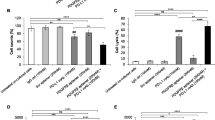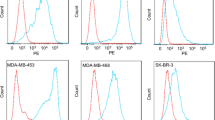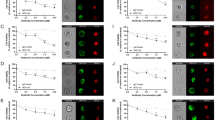Abstract
Background
Triple-negative breast cancers (TNBCs) are highly aggressive and metastatic. To date, finding efficacious targeted therapy molecules might be the only window of hope to cure cancer. Fibromodulin (FMOD), is ectopically highly expressed on the surface of Chronic Lymphocytic Leukemia (CLL) and bladder carcinoma cells; thus, it could be a promising molecule for targeted therapy of cancer. The objective of this study was to evaluate cell surface expression of FMOD in two TNBC cell lines and develop an antibody–drug conjugate (ADC) to target FMOD positive TNBC in vitro and in vivo.
Materials and methods
Two TNBC-derived cell lines 4T1 and MDA-MB-231 were used in this study. The specific binding of anti-FMOD monoclonal antibody (mAb) was evaluated by flow cytometry and its internalization was verified using phAb amine reactive dye. A microtubulin inhibitor Mertansine (DM1) was used for conjugation to anti-FMOD mAb. The binding efficacy of FMOD-ADC was assessed by immunocytochemistry technique. The anti-FMOD mAb and FMOD-ADC apoptosis induction were measured using Annexin V-FITC and flow cytometry. Tumor growth inhibition of anti-FMOD mAb and FMOD-ADC was evaluated using BALB/c mice injected with 4T1 cells.
Results
Our results indicate that both anti-FMOD mAb and FMOD-ADC recognize cell surface FMOD molecules. FMOD-ADC could induce apoptosis in 4T1 and MDA-MB-231 cells in vitro. In vivo tumor growth inhibition was observed using FMOD-ADC in 4T1 inoculated BALB/c mice.
Conclusion
Our results suggests high cell surface FMOD expression could be a novel bio-marker TNBCs. Furthermore, FMOD-ADC could be a promising candidate for targeting TNBCs.







Similar content being viewed by others
References
Mattiuzzi C, Lippi G. Current cancer epidemiology. J Epidemiol Glob Health. 2019;9(4):217.
Weir HK, Thompson TD, Soman A, Møller B, Leadbetter S. The past, present, and future of cancer incidence in the United States: 1975 through 2020. Cancer. 2015;121(11):1827–37.
Sung H, Ferlay J, Siegel RL, Laversanne M, Soerjomataram I, Jemal A, et al. Global cancer statistics 2020: GLOBOCAN estimates of incidence and mortality worldwide for 36 cancers in 185 countries. Cancer J Clin. 2021;71(3):209–49.
Si Y, Xu Y, Guan J, Chen K, Kim S, Yang ES, et al. Anti-EGFR antibody-drug conjugate for triple-negative breast cancer therapy. Eng Life Sci. 2021;21(1–2):37–44.
Esteva FJ, Hubbard-Lucey VM, Tang J, Pusztai L. Immunotherapy and targeted therapy combinations in metastatic breast cancer. Lancet Oncol. 2019;20(3):e175–86.
Kimiz-Gebologlu I, Gulce-Iz S, Biray-Avci C. Monoclonal antibodies in cancer immunotherapy. Mol Biol Rep. 2018;45(6):2935–40.
Reichert JM, Rosensweig CJ, Faden LB, Dewitz MC. Monoclonal antibody successes in the clinic. Nat Biotechnol. 2005;23(9):1073–8.
Zahavi D, Weiner L. Monoclonal antibodies in cancer therapy. Antibodies. 2020;9(3):34.
Chari RV. Targeted cancer therapy: conferring specificity to cytotoxic drugs. Acc Chem Res. 2008;41(1):98–107.
Khongorzul P, Ling CJ, Khan FU, Ihsan AU, Zhang J. Antibody–drug conjugates: a comprehensive review. Mol Cancer Res. 2020;18(1):3–19.
Verma S, Miles D, Gianni L, Krop IE, Welslau M, Baselga J, et al. Trastuzumab emtansine for HER2-positive advanced breast cancer. N Engl J Med. 2012;367(19):1783–91.
Congreve S, Faris Elias R, Tidestav G, Zafranian v. Antibody drug conjugates (ADC): current status and mapping of ADC: s in clinical programs, 2018. http://urn.kb.se/resolve?urn=urn:nbn:se:uu:diva-352917
Spring LM, Nakajima E, Hutchinson J, Viscosi E, Blouin G, Weekes C, et al. Sacituzumab govitecan for metastatic triple-negative breast cancer: clinical overview and management of potential toxicities. Oncologist. 2021;26(10):827–34.
Wahby S, Fashoyin-Aje L, Osgood CL, Cheng J, Fiero MH, Zhang L, et al. FDA approval summary: accelerated approval of sacituzumab govitecan-hziy for third-line treatment of metastatic triple-negative breast cancer. Clin Cancer Res. 2021;27(7):1850–4.
Romero D. Benefit in patients with PD-L1-positive TNBC. Nat Rev Clin Oncol. 2019;16(1):6–6.
Zent R, Pozzi A. Cell-extracellular matrix interactions in cancer. Berlin: Springer; 2010.
Krishnan L, Hoying JB, Nguyen H, Song H, Weiss JA. Interaction of angiogenic microvessels with the extracellular matrix. Am J Physiol-Heart Circ Physiol. 2007;293(6):H3650–8.
Naito Z. The role of small leucine-rich proteoglycan (SLRP) family in pathological lesions and cancer cell growth. J Nippon Med Sch. 2005;72(3):137–45.
Iozzo RV, Schaefer L. Proteoglycans in health and disease: novel regulatory signaling mechanisms evoked by the small leucine-rich proteoglycans. FEBS J. 2010;277(19):3864–75.
Soo C, Hu F-Y, Zhang X, Wang Y, Beanes SR, Lorenz HP, et al. Differential expression of fibromodulin, a transforming growth factor-β modulator, in fetal skin development and scarless repair. Am J Pathol. 2000;157(2):423–33.
Lee Y-H, Schiemann WP. Fibromodulin suppresses nuclear factor-κb activity by inducing the delayed degradation of IKBA via a JNK-dependent pathway coupled to fibroblast apoptosis. J Biol Chem. 2011;286(8):6414–22.
DawoodyNejad L, Biglari A, Annese T, Ribatti D. Recombinant fibromodulin and decorin effects on NF-κB and TGFβ1 in the 4T1 breast cancer cell line. Oncol Lett. 2017;13(6):4475–80.
Bettin A, Reyes I, Reyes N. Gene expression profiling of prostate cancer-associated genes identifies fibromodulin as potential novel biomarker for prostate cancer. Int J Biol Markers. 2016;31(2):153–62.
Reyes N, Benedetti I, Bettin A, Rebollo J, Geliebter J. The small leucine rich proteoglycan fibromodulin is overexpressed in human prostate epithelial cancer cell lines in culture and human prostate cancer tissue. Cancer Biomark. 2016;16(1):191–202.
Colin C, Baeza N, Bartoli C, Fina F, Eudes N, Nanni I, et al. Identification of genes differentially expressed in glioblastoma versus pilocytic astrocytoma using Suppression Subtractive Hybridization. Oncogene. 2006;25(19):2818–26.
Farahi L, Ghaemimanesh F, Milani S, Razavi SM, Hadavi R, Bayat AA, et al. GPI-anchored fibromodulin as a novel target in chronic lymphocytic leukemia: diagnostic and therapeutic implications. Iran J Immunol. 2019;16(2):127–41.
Bayat A-A, Sadeghi N, Salimi A, Fazli G, Nowroozi MR, Moghadam SO, et al. The association of cell surface fibromodulin expression and bladder carcinoma. Urol J. 2021. https://doi.org/10.22037/uj.v18i.6461.
Choudhury A, Derkow K, Daneshmanesh AH, Mikaelsson E, Kiaii S, Kokhaei P, et al. Silencing of ROR1 and FMOD with siRNA results in apoptosis of CLL cells. Br J Haematol. 2010;151(4):327–35.
Riggio AI, Varley KE, Welm AL. The lingering mysteries of metastatic recurrence in breast cancer. Br J Cancer. 2020;124:1–14.
Bi X-L, Yang W. Biological functions of decorin in cancer. Chin J Cancer. 2013;32(5):266.
Pourhanifeh MH, Mohammadi R, Noruzi S, Hosseini SA, Fanoudi S, Mohamadi Y, et al. The role of fibromodulin in cancer pathogenesis: implications for diagnosis and therapy. Cancer Cell Int. 2019;19(1):1–9.
Mikaelsson E, et al. Fibromodulin, an extracellular matrix protein: characterization of its unique gene and protein expression in B-cell chronic lymphocytic leukemia and mantle cell lymphoma. Blood. 2005;105(12):4828-4835.
DeNardo SJ. Radioimmunodetection and therapy of breast cancer. In: Seminars in nuclear medicine. Amsterdam: Elsevier; 2005.
Acknowledgements
This work was supported by grants from Avicenna Research Institute, ACECR, Tehran, Iran (Grant No. 960205-012) and Tehran University of Medical Sciences, Tehran, Iran (Grant No. 97-03-87-40182).
Author information
Authors and Affiliations
Corresponding author
Ethics declarations
Conflict of interest
The authors declare that they have no conflict of interests.
Ethical approval
All procedures performed in studies involving animals were in accordance with the ethical standards of the ethics committee of Tehran University of Medical Sciences. (Approval number: IR.TUMS.VCR.REC.1397.1079).
Additional information
Publisher's Note
Springer Nature remains neutral with regard to jurisdictional claims in published maps and institutional affiliations.
About this article
Cite this article
Haji Ghaffari, M., Simonian, M., Salimi, A. et al. A novel ADC targeting cell surface fibromodulin in a mouse model of triple-negative breast cancer. Breast Cancer 29, 1121–1132 (2022). https://doi.org/10.1007/s12282-022-01393-7
Received:
Accepted:
Published:
Issue Date:
DOI: https://doi.org/10.1007/s12282-022-01393-7




